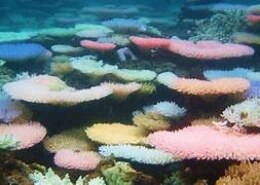Given the following scenario: A forest ecosystem has been affected by a severe drought. Analyze the potential impact of the drought on the plant and animal species within this ecosystem. What changes might occur in the food web?
Coral reefs in India are experiencing significant bleaching due to a combination of environmental and anthropogenic factors. Some of the key contributors to this phenomenon include: 1. Increased Sea Surface Temperatures: One of the primary drivers of coral bleaching is the rise in sea surface temperRead more
Coral reefs in India are experiencing significant bleaching due to a combination of environmental and anthropogenic factors. Some of the key contributors to this phenomenon include:
1. Increased Sea Surface Temperatures: One of the primary drivers of coral bleaching is the rise in sea surface temperatures. Indian coastal waters have seen significant warming due to climate change. Corals are highly sensitive to temperature fluctuations, and even a slight increase can cause them to expel the symbiotic algae living in their tissues, leading to bleaching.
2. El Niño Events: These periodic climate events cause significant warming of ocean waters in various parts of the world, including the Indian Ocean. El Niño can exacerbate local temperature increases, leading to widespread bleaching events.
3. Pollution and Runoff: Coastal pollution from agricultural runoff, untreated sewage, and industrial effluents introduces harmful substances into the ocean. Nutrient-rich runoff can lead to algal blooms that block sunlight and further stress corals, while toxic pollutants can directly damage coral tissues.
4. Overfishing and Destructive Fishing Practices: The depletion of fish populations due to overfishing disrupts the ecological balance of coral reefs. Additionally, practices like blast fishing and cyanide fishing cause direct physical damage to coral structures.
5. Sedimentation from Coastal Development: Increased sedimentation from construction, deforestation, and other land-use changes reduces water quality and light penetration, essential for coral health. Sediments can smother corals, making it difficult for them to feed and grow.
6. Ocean Acidification: The absorption of excess atmospheric CO₂ by the ocean leads to lower pH levels, which affect the ability of corals to produce and maintain their calcium carbonate skeletons. This weakens the corals, making them more susceptible to bleaching and disease.
7. Invasive Species: The introduction of non-native species can disrupt local ecosystems and compete with corals for resources, adding another layer of stress to already vulnerable reefs.
8. Tourism and Recreational Activities: Unsustainable tourism practices, such as anchor dropping, trampling by divers, and coastal development for tourist infrastructure, can physically damage reefs and increase pollution levels.
Efforts to address coral bleaching in India involve a multi-faceted approach, including:
Mitigating Climate Change: Reducing global greenhouse gas emissions to limit global warming and subsequent sea temperature rise.
Improving Coastal Management: Implementing better land-use practices to reduce sedimentation and pollution runoff.
Establishing Marine Protected Areas: Creating and enforcing protected zones to safeguard coral reefs from destructive human activities.
Promoting Sustainable Fishing: Regulating fishing practices to prevent overfishing and protect reef ecosystems.
Raising Awareness: Educating local communities and tourists about the importance of coral reefs and how to minimize their impact on these ecosystems.
By addressing these factors, it is possible to reduce the incidence of coral bleaching and promote the resilience and recovery of coral reefs in India.
See less

A drought of a severe nature in a forest ecosystem may cause a great effect on plant and animal species, causing significant changes to the food web. Effect on Plants Growth and Productivity: Drought stress slows down the growth rates of plants, results in smaller leaf sizes, and reduced photosyntheRead more
A drought of a severe nature in a forest ecosystem may cause a great effect on plant and animal species, causing significant changes to the food web.
Effect on Plants
Growth and Productivity: Drought stress slows down the growth rates of plants, results in smaller leaf sizes, and reduced photosynthesis. This affects their ability to produce biomass- the base of the food web that is made up of leaves, stems, fruits.
-Increased Death: Severe drought can cause a significant increase in tree deaths, especially the drought-sensitive tree species. The loss of vegetation decreases the overall plant biomass as well as shifts the forest’s structure.
Change in Species Population: Drought-resistant species would thrive while susceptible species decline in population, thus changing the plant community composition with time. Eventually, this change will alter the structure and the function of the ecosystem.
Nevertheless, seed production can be significantly reduced in many plant species due to drought, affecting recruitment of new individuals and long-term population dynamics.
Effects to Animals:
food scarcity: Herbivores are also directly affected by reduced growth and productivity of plants, thus leading to food shortages and greater competition for available resources.
Habitat Loss : Tree death, in turn, results in habitat loss for many species of animals that might be dependent on the death tree for food, shelter or as a nesting area.
Changes in Animal Behavior: Drought-stressed food is likely to change foraging patterns for animals that will respond to scarcity by changing breeding habits, some by moving to other locations.
Increased Susceptibility to Predation: Drought-stressed animals may become susceptible to predators.
Changes in the Food Web:
Decreases in Herbivorous Populations: Decreases in herbivorous populations may indicate reduced plant biomass and have direct implications for their predators, which feed on herbivores.
Changes in Predator-Prey Interactions: Changes in herbivorous populations may indicate changes in predator-prey relationships that may translate to population declines for some species of predators while increasing for others.
Cascading Effects: Such changes at the lower trophic levels, like plants and herbivores, may cascade into effects throughout the food web to higher-level predators, scavengers, and decomposers.
Increased Competition: Reduced resources can increase competition between species at all trophic levels.
See less